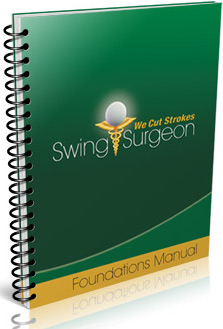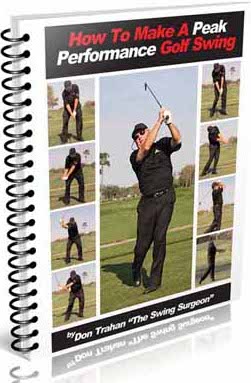You've heard me say before that our knees act as our levelers and stabilizers. We don't want to let our knees collapse inward because it will cause us to lose the rest of our angles of the swing. But, in order to control the knees, you must be aware of what your feet are doing.
Ken Silva had a question that stemmed from reading the Peak Performance Golf Swing manual. He was a little confused on the role of the left foot during the backswing. He wasn't sure if it should roll inward during the backswing and, if so, how much. So, today I'm going to discuss just exactly how the left foot should be used.
Surge,
I believe I understand most of what you have said in previous videos. I recently purchased the 23 page manual and have a question. On page 7, item listing 5, there are two sentences. The first one (keep left foot planted) is easy. The second one I do not recall hearing. "Let the weight roll to the inside of the left foot". This is during the lift and is this telling me that the weight on the outside of the left foot transfers to the inside of the left foot during the lift portion? I presume it does not tell me that all the weight is now on the inside portion of the left foot. Please explain.
Thanks,
Ken
 CLICK HERE FOR YOUR OWN COPY OF THE PEAK PERFORMANCE GOLF SWING MANUAL
CLICK HERE FOR YOUR OWN COPY OF THE PEAK PERFORMANCE GOLF SWING MANUAL
 CLICK HERE FOR YOUR OWN COPY OF THE PEAK PERFORMANCE GOLF SWING MINI-MANUAL (fits in your bag!)
CLICK HERE FOR YOUR OWN COPY OF THE PEAK PERFORMANCE GOLF SWING MINI-MANUAL (fits in your bag!)
This is one of the things that varies in the PPGS from golfer to golfer because of our physical differences such as height, weight, and flexibility. That being said, I'm going to walk you through what I feel when I'm swinging a golf club.
The more stable you keep the forward knee, the better. When I get set up over the ball, my feet are flat on the ground with the weight in my arches. Never let your feet roll inward or outward too much. I have very little knee movement. I'm not the most flexible golfer in the world, but that's good for me because it decreases my chances of over-turning. Some people are really flexible and have to make a conscious effort to stay within the parameters of the PPGS. Whatever you do, don't let your knees or feet collapse inward. I never collapse to the inside of my left foot. You should never get to the point where your hip starts to get pulled down because of the knee collapsing inward. It will change every angle in your body, so avoid it at all cost.
My knee probably doesn't move any more than an inch. Anything more than two inches will most likely lead to some sort of a knee collapse. The left knee is the gauge. When you maintain your outward pressure with the knees, you'll get a nice stretch so that during your transition, you'll be able to rip the ball more solid and straight while keeping your balance on the way up to the T-finish.
Our muscles must be engaged in order to hit the ball with any kind of power, but we can't let our left foot or knee collapse inward because all of that stored energy will become lost. It will also become much more difficult to have a square club at impact because your angles have been compromised.
Keep it vertical!
The Surge
If you can't view the YouTube video above try CLICKING HERE. You must allow popups from this site for the link to work.
Comments
Touche
Touche Don, I envy you on your physical proportions, makes for being a better athlete in most sports, not like us 68 tall skinny folk which have to fight all the way, I think I can still do some things that 40-50 year olds can't.
I recently videoed myself after 4 months and was gobsmacked
how far I was in the SGB, when I thought I was only doing a half swing.
Now it's back to the drawing board and the "sun as my buddy" to check on "my place in space", mate this game is damn hard.
Keep 'em quiet
Surge, thanks for the reminder to keep our front knee still during the back swing.
I know for me keeping the angles quieter, especially the lower body and head has made getting back to the ball with solid, centered contact much more likely and frequent. Always amazed how pure and sweet it feels. It is what I call part of "keeping it neat". Fewer angles and keeping it simple equals great results most of the time.
Looking forward to a lot of good golf as the warmer days come along. Was crazy weather for the boys down in Tucson this week. Speaking of which I have taken a bit of interest in winner Matt Kutcher's putting method and did a little research last night. His long putter braced on the forearm will continue to be okay even with the coming anchoring ban so I thought I'd give it a go.
I will leave you all with some excellent videos I found including segments with his putting coach. One is especially long and includes some amazing explanations of what is included in a good putting method. Worth the watch, especially for you gear head how to lines and angle guys like me.
Steve Smith, I think the one from his putting coach may have you filming and analyzing. you'll see what I mean.
PUTTING.................................
Regardless of your grip style and even with a standard length putter,
what do the best putters have in common technically speaking?
http://www.youtube.com/watch?v=MU6Wko5e8bs
http://www.youtube.com/watch?v=PdAe49KPU5I
http://www.youtube.com/watch?v=OgWl2GlywxQ
http://www.youtube.com/watch?v=OgWl2GlywxQ
Putting
It would be interesting to have the equipment for measuring those putting lines.
Even a high speed camera, a yard stick, and the V1 progam could do most of it. (I have all but the high speed camera...Maybe some day). LOL
About all the Zi8 is good enough for is static positions. The moving stroke is too blurry to get accurate club face angle measurements with that camera. Some system for accurate and consistent camera placement in relation to the putting line would be necessary too.
P.S. Videos I have taken with my camera show that my putter is 1 degree open at address and starts 1/2 inch behind the ball when the roll is perfectly down the line. I could get the right arm angles at address (and I may do that) just to see if I am in the neighborhood of what that coach teaches. My guess is that the right arm angles are pretty close.
The only thing he teaches that doesn't feel right to me is the "connection" of the left elbow. My right elbow is connected but I like the feel of my left elbow clear of my side and to bring it in tighter and connect it to my side not only feels less comfortable but causes my backstroke to come inside of the line more and I am less accurrate.
I would describe my putting stroke as the right forearm and shaft in line and my elbow touching just at the top of the point of my right hip, with the forearm and shaft basically forming a "belly putter" but anchored against my hip instead of the center of my belly (but not tightly). The left hand isn't playing much of a part except for stabalization and almost operating like the right arm does for most people when using the claw grip.
P.S. My "belly putter" that is formed by the shaft and my right forearm is more than likely the reason I am best with the ball a couple inches back of center in my stance.
Right elbow
Steve,
You must have a much longer upper arm than I do. My right elbow touches at my bottom rib, 6 inches above my hip point. That explains why I can't putt the same as those with whom I regularly play. I putt with the ball slightly forward of center and almost the same grip as I use for every other club. I usually putt with a miniature version of my pitching stroke.
Different
I would say that most of us do things differently if we really break down the small things.
Making a good roll consistently is all that really matters in the end.
Now if we could just always make the right read!!!!!! Hahaha!
Letting my elbow rest against my hip point just comes natural to me, and works too well to change it.
http://www.youtube.com/watch?v=pawBktJOaJY
Interetsing stuff
Thanks for your reply Steve. I thought you and several others might enjoy the dissecting of the putting stroke by Mike Shannon. Not yet sure about the left elbow position yet. I am still exploring the possibilities. I have putted much better the past few months with the Phil M. pencil/saw grip and stroke style I've been using. I have had at least one or more birdies every round the past 2 months, much due to improved putting. Now he says you can accomplish the angles he encourages with a variety of grip styles. I am going to fool around with the "belly" up the left arm style that Kutch uses. I particularly like what he said about how we are best off keeping the arch under 8 degrees of variance on both sides in the first few inches back and through otherwise it comes down to timing more so. That seems to go right along with what Surge teaches with the on on and on idea. Too, It Is fascinating what that coach says about what the best putters seem to all have in common. We'll see to what extent I adapt his methods. I am looking at it closely and if it can help my consistency I'm in :)
Putting coach
He sounds like a good coach.
It would be nice to establish the base line for what works best with all of that equipment. Then if something started to go wrong it would be easier to fix.
Left Knee
Surge
Great reminder. It's all about the basics. It's 50 and cloudy here and snow is gone. Heading out to chase the little white ball with a narrow stance and left knee focused. TY for the reminder.
Pre loaded heavy right ?
Surge,
I must have miss understood something with this video. Don't we pre load heavy right? , it seems from 2 minutes in to this video you say we should be equally balanced in both feet, ready to move equally easily in both directions.
I am a big fan of the PPGS, just a bit unclear on this point.
Never outside edge
1957, good year, I was born in May of that year. dward, don't be confused, Surge is simple talking about never allowing our weight to shift to the OUTSIDE of either foot. We can be (and should be) PLHR and still be over the foot and in line with the back leg as he has spoken about many times. The feet being flared out assists this set up while still keeping the stance relatively narrow. Too, remember the PLHR can be over done. Surge talks about a one inch shift over ans on to the back foot with weight still in the arch of that foot too.